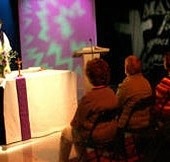The most popular posts on this blog — far and away the most popular — relate to Maria Divine Mercy. Her messages, which prophesy cataclysm and suggest Francis is an anti-pope, are quite an online phenomenon.
I’ve only posted on the subject twice (here and here), but two months later, those posts continue to attract new visitors and a great many private e-mails and Facebook messages.
Many respondents agree with me, and some have asked me to promote their own critiques of the MDM messages. On the one hand, I’m not sure any apostolate which is primarily reactionary is very fruitful. But on the other hand, these people are faithful and charitable, and who am I to discourage their works? So here are two blogs which may be of interest to devotees and critics of MDM:
- Maria Divine Mercy: True or False? Our mission: Unmasking demonic deception.
- Refuting Maria Divine Mercy. Illustrating how the messages of Maria Divine Mercy are simply false.
Many other respondents disagree with me, and to their credit, the greater part are respectful about it. Some have asked that I pray a daily prayer that Maria Divine Mercy recommends to priests discerning her messages:
My Lord, open my eyes. Allow me to see the enemy and close my heart to deceit. I surrender all to You, dear Jesus. I trust in Your Mercy. Amen.
It’s not a bad prayer. It’s simple enough to pray each day, and so I have indeed included it in my daily prayers, with a small addition:
My Lord, open my eyes. Allow me to see the enemy and close my heart to deceit. I surrender all to You, dear Jesus, Son of the Living God, conceived by the Holy Spirit and born of the Virgin Mary. I trust in Your Mercy. Amen.
The modification clarifies who exactly I’m praying to, which is a detail exorcists advise. I remain very dubious of the MDM thing. It may be authentic, it may be a human fraud, or it may be something more nefarious.
Correction
Apart from all that, I have been asked to correct an error in one of my previous posts. I quoted a warning against private revlations from St John of the Cross, one of the Church’s great mystics. From The Ascent of Mt Carmel, Bk II, Ch 11. (objectionable content in bold):
It is clear, then, that these sensual apprehensions and visions cannot be a means to union, since they bear no proportion to God; and this was one of the reasons why Christ desired that the Magdalene and Saint Thomas should not touch Him. And so the devil rejoices greatly when a soul desires to receive revelations, and when he sees it inclined to them, for he has then a great occasion and opportunity to insinuate errors and, in so far as he is able, to derogate from faith; for, as I have said, he renders the soul that desires them very gross, and at times even leads it into many temptations and unseemly ways.
This is Edgar Allison Peers’ rendering (1962), which is generally recognised as the twentieth century’s definitive translation. But as one eagle eyed reader has pointed out, our Lord did not discourage St Thomas from touching him.
Here is an older translation, by David Lewis (1896):
It is now clear that these visions and apprehensions of sense cannot be the means of the divine union, for they bear no proportion to God. And this is one of the reasons why Christ would not suffer Mary Magdalene to touch Him, and yet allowed it, as the better and more perfect course, to St. Thomas. The devil rejoices greatly when a soul seeks after revelations and is ready to accept them; for such conduct furnishes him with many opportunities of insinuating delusions, and derogating from faith as much as he possibly can; for such a soul becomes rough and rude, and falls frequently into many temptations and unseemly habits.
It seems the error was the translator’s, not the author’s.
A reader with better Spanish than me has confirmed that the error is St John’s, not the translator’s. I imagine David Lewis corrected a perceived error, where E. Allison Peers was faithful to the original text.
It reminds me of the translation of a point in St Josemaría Escrivá’s Camino, which related an unidentified priest’s “butter tragedy” — shorthand for the ascetical struggle in little things. The first Irish editions of The Way rendered this the “marmalade tragedy,” since the translators imagined this might be better understood by Irish readers.
The more faithful translation was only provided when the “holy man of God” was identified as Fr William Doyle, an Irish Jesuit! If the “butter tragedy” originated in Ireland, it should be recalled as such in Ireland!






Zzzzzzzzzzzzzzzzzzzzzzz. Wake me up when it’s all over, Padre.
Actually, Alison Peers translation of this text is accurate while the Lewis text is simply wrong. I just checked my Obras Completas de San Juan de la Cruz. So it may well be that the Mystical Doctor slipped. Does it matter? It does not affect his main point.
BTW Peers died in 1952, some 61 years ago. Translations are never definitive as the language into which a text is translated changes with time. As well, important critical work has been done on the original since 1952.
Fascinating! I was surprised that Allison Peers would err where Lewis did not. I owe him an apology — and his collaborators, given that the edition I quoted from must have been prepared posthumously.
I’d maintain that EAP’s was the definitive translation in its time, though you’re quite right that something new will supersede it.
Does it matter? No, I’m with you Gregor Mor. St John’s point stands: beware the appetite for visions and messages.
There are those who say MarieDivineMercy is not to be believed because Jesus said that Pope Benedict would flee from the Vatican. Pope Benedict did resign saying in effect he felt that he wasn’t up to the job because of his years and that he does this on his own freewill. For this resignation and the new pope’s election to be legitimate, these words were absolutely mandatory according to Canon Law. But in 2005, did not Pope Benedict XVI prophesize how his own pontificate would end at the very first Mass that he celebrated as Pope???? “Pray for me, that I may not flee for fear of the wolves.”
Did he flee from the wolves, especially those within the Church, who he knew would inevitably, incessantly attack him during his pontificate?… Were these wolves more ferocious than he anticipated in response to his determined rolling back of some of the chaos that followed Vatican II and his strong rebukes to all the elements of the Culture of Death….. Now think how much more Benedict has had to endure for his heroic attempts to steer the entire, badly damaged, diminished, wayward Church back on course away from the errors and influence of the “progressives” and other dissidents. They have been howling with rage over his undoing of their five decades of control. He has spoiled their plans for a morally and theologically liberal church remade in their own image, rather than Christ’s…
Catholic commentator, George Neumayr, in his article The Reluctant Pope, lists some of Benedict’s notable accomplishments “trivialized and discredited” by many:
“his battles with the dictatorship of relativism,’ his promotion of wider use of the traditional Latin Mass, his reinstitution of the ban on the ordination of homosexuals to the priesthood, his historic overture to disaffected Anglicans, his voluminous stream of speeches and writings that aimed at repairing the catechetical collapse within the Church; his insistence on the ‘non-negotiable’ character of the natural moral law in shaping politics and culture.”
Benedict’s greatest and nearly-unbearable crosses have likely come from opposition to, hatred for, and outright rejection of his reforms – the opposition coming from many in influential positions within the Church – at all levels. ..In his blog, Benedict XVI: Reason’s revolutionary, The Acton Institute’s Samuel Gregg explains some of the reasons for the animosity Benedict has experienced:
“Intellectually, Ratzinger far surpassed the usual suspects who want to turn Catholicism into something between the disaster otherwise known as the Church of England, and the rather sad leftist-activism of aging nuns stuck in 1968. But against the increasingly-absurd rants of a Hans Kung or Leonardo Boff, Ratzinger simply continued defending and explaining orthodox Christianity’s essential rationality with a modesty lacking in his opponents.”
Gregg also mentions the pope’s “efforts to root out what Ratzinger once called the ‘filth’ of sexual deviancy” which I have repeatedly noted on this website is a job still far from completed. He has been able to complete this and his other priority tasks only to the extent that the difficult Church bureaucracies and the world’s bishops have followed his urging and well reasoned pleadings.
There has been much resistance, some of it astonishingly vicious and rebellious, especially from clergy and laity in the wealthy, developed nations. Benedict has been betrayed even by those closest to him within the Vatican itself.
Benedict’s exceptional appeals to reason, if accepted, writes, Gregg, translate “into changes in lifestyles that many people simply don’t want to make. But a pope’s job isn’t to tell people what they want to hear.”
But as we have noticed in recent years, reason is increasingly rejected, and changeable feelings and desires are given more emphasis in decision-making by persons and organizations. Anyone who dares to instruct them in what is best regarding their bodies, their sexuality, their theology or their ego, is increasingly seen as a hateful personal aggressor rather than a loving father or other teacher.
I wish that Benedict could have held on for at least several more months to complete more of his necessary reforms and to appoint more faithful bishops.
In my opinion, “Is it unreasonable to believe, that the good and gracious Benedict, chose to make a good and gracious exit and not reveal all the ugliness and evil attacks towards him and his pontificate? Were there nefarious other threats coming his way if he didn’t step down. Interesting how the International Criminal Court at The Hague dropped all their charges against him, after he quit. Jesus through Divine Mercy said that Pope Benedict was being charged with crimes that he was not guilty of. What else were the enemies of God planning for Benedict that didn’t manifest because he finally gave them what they wanted – his retirement.
Pope Benedict knew how it would all end for him since the very beginning of his Pontificate. He did flee the wolves.
The Source of much that is written above is from LifeSite.